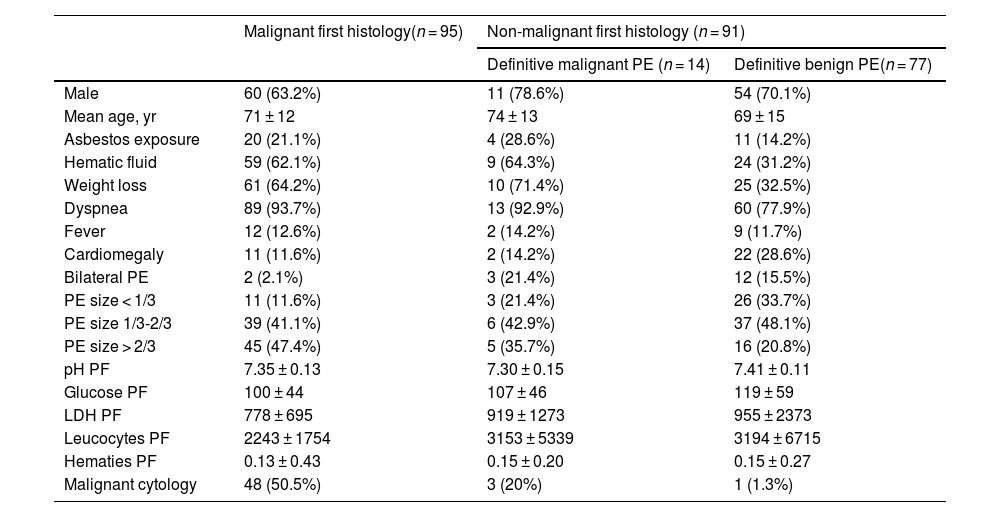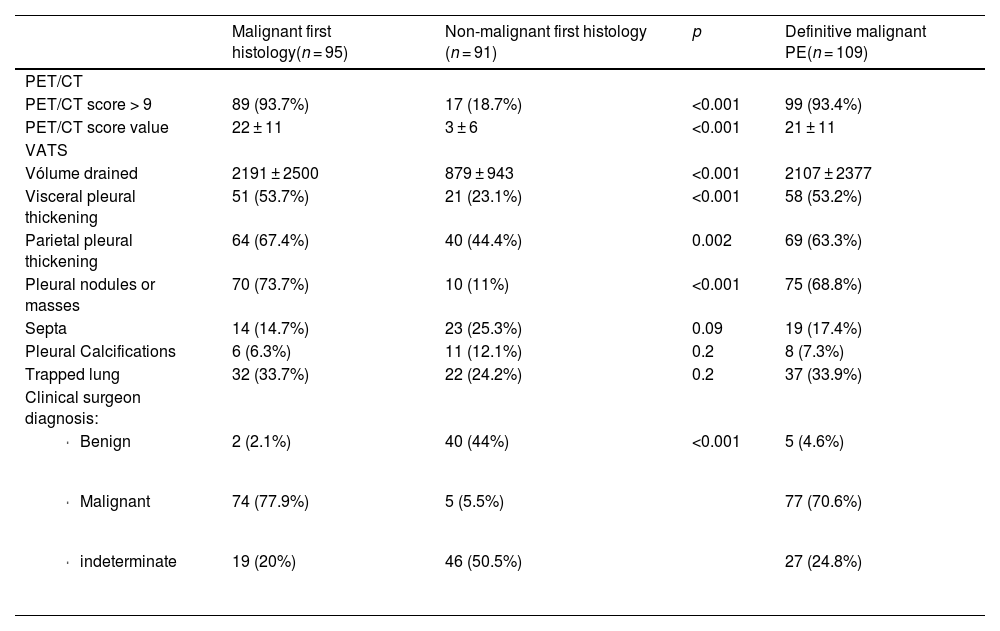Histological analysis of the pleura obtained by video-assisted thoracoscopic surgery (VATS) is the best diagnostic technique in the study of neoplastic pleural effusions. This study evaluates the relationship between Positron Emission Tomography (PET)/Computed Tomography (CT) and VATS findings, the result of the first pleural biopsy, and the final diagnosis of malignancy or non-malignancy.
MethodsProspective study of consecutive patients with pleural effusions undergoing PET/CT and VATS from October 2013 to December 2023. The following variables were recorded: PET/CT score (nodular pleural thickening, pleural nodules with standardized uptake value (SUV) > 7.5, lung mass or extra pleural malignancy, mammary lymph node with SUV > 4.5 and cardiomegaly); VATS data (drained volume, visceral and parietal pleural thickening, nodules or masses, septa, plaques, fluid appearance, trapped lung, and suspected diagnosis of the procedure), as well as the histological study of the first pleural biopsy (benign or malignant) and the final diagnosis of benign or malignant pleural effusion. A logistic regression study of the variables was performed.
Results95.8% of the patients with PET/CT and pleuroscopy not suggestive of malignancy had non-malignant histological findings, while 93.2% of the patients with PET/CT and pleuroscopy suggestive of malignancy had malignant histological findings. PET/CT, pleuroscopy, and the result of the first pleural biopsy showed a significant association with the final diagnosis of pleural effusion.
ConclusionsThere is a strong association between PET/CT findings, VATS and pleural histology.
El análisis histológico de la pleura obtenido mediante videotoracoscopia asistida (VATS) es la mejor técnica diagnóstica en el estudio de los derrames pleurales neoplásicos. Este estudio evalúa la relación entre la Tomografía por Emisión de Positrones (PET) - Tomografía Axial Computarizada (TAC) y los hallazgos de VATS, el resultado de la primera biopsia pleural y el diagnóstico final de malignidad o no malignidad.
MétodosEstudio prospectivo de pacientes consecutivos con derrame pleural sometidos a PET-TAC y VATS desde octubre de 2013 a diciembre de 2023. Se registraron las siguientes variables: puntuación PET-TAC (engrosamiento pleural nodular, nódulos pleurales con valor de SUV > 7,5, masa pulmonar o neoplasia maligna extrapleural, ganglio linfático mamario con SUV > 4,5 y cardiomegalia); datos de la VATS (volumen drenado, engrosamiento pleural visceral y parietal, nódulos o masas, septos, placas, aspecto líquido, pulmón atrapado y diagnóstico de sospecha del procedimiento), así como el resultado histológico de la primera biopsia pleural (benigna o maligna) y el diagnóstico final de derrame pleural benigno o maligno. Se realizó un estudio de regresión logística de las variables.
ResultadosEl 95,8% de los pacientes con PET-TAC y pleuroscopia no sugestiva de malignidad tuvieron hallazgos histológicos no malignos, mientras que el 93,2% de los pacientes con PET-TAC y pleuroscopia sugestiva de malignidad tuvieron una histología neoplásica. La PET-TAC, la pleuroscopia y el resultado de la primera biopsia pleural mostraron una asociación significativa con el diagnóstico final de derrame pleural.
ConclusionesExiste una fuerte asociación entre los hallazgos de PET-TAC, VATS e histología pleural.
Artículo

Revista Española de Medicina Nuclear e Imagen Molecular (English Edition)
Comprando el artículo el PDF del mismo podrá ser descargado
Precio 19,34 €
Comprar ahora










